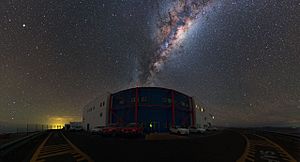Dark-sky preserve facts for kids

A dark-sky preserve (also called a DSP) is a special protected area. It is kept free from light pollution made by humans. Light pollution happens when too much artificial light from cities makes it hard to see the stars at night. These special areas help people enjoy and study astronomy, which is the study of stars and planets.
Different countries have their own ways to create these preserves. The International Dark-Sky Association (IDA) uses specific names. They call some places International Dark Sky Reserves (IDSR). Others are called International Dark Sky Parks (IDSP). This helps avoid confusion between different types of dark-sky areas.
In Canada, there are very strict rules for dark-sky preserves. These rules look at how much light is in an area. They also check for skyglow. Skyglow is the glow in the sky from nearby cities. Canada's program is unique in the world. Outside Canada, some places might be called dark-sky preserves. But they might not be officially protected or truly dark.
Contents
What is a Dark-Sky Preserve?
A dark-sky preserve is a place where the night sky is kept very dark. This means there is little to no light pollution. Light pollution comes from streetlights, buildings, and other human-made lights. It makes it hard to see stars, planets, and the Milky Way.
Why are Dark-Sky Preserves Important?
Dark-sky preserves are important for many reasons:
- For Astronomy: They provide clear views of the night sky. This is perfect for astronomers and anyone who loves stargazing. You can see thousands of stars that are usually hidden by city lights.
- For Wildlife: Many animals depend on natural darkness. Light pollution can confuse animals. It affects their sleep, hunting, and migration patterns. Dark-sky preserves help protect these animals.
- For Energy Saving: Reducing light pollution means using less energy. This helps the environment. It also saves money.
- For Our Health: Too much artificial light at night can affect human sleep. It can also impact our health. Natural darkness helps our bodies stay healthy.
How are Dark-Sky Preserves Created?
Places become dark-sky preserves by following strict rules. These rules are about how lights are used. For example, lights might need to point downwards. They might also need to be a certain color.
The IDA works with communities around the world. They help places get certified as dark-sky parks or reserves. This certification means the area meets high standards for protecting the night sky.
Where Can You Find Dark-Sky Preserves?
Dark-sky preserves are found all over the world. They can be national parks, forests, or even small communities. Here are a few examples from different countries:
- Australia:
- Warrumbungle National Park in New South Wales was named a Dark Sky Park in 2016. It's a large area perfect for stargazing.
- Canada:
- Jasper National Park in Alberta is a huge dark-sky preserve. It was designated in 2011. You can see amazing stars there.
- Mont Mégantic Observatory in Quebec was the first IDA International Dark-Sky Reserve in Canada. It's home to an observatory.
- Europe:
- The Beskydy Dark-Sky Park is special. It crosses two countries: the Czech Republic and Slovakia. It became a dark-sky park in 2013.
- Pic du Midi de Bigorre in France is a Dark Sky Reserve. It was the first in France and Europe.
- Galloway Forest Park in Scotland, United Kingdom, became a dark-sky park in 2009. It's a great place to see the night sky.
- United States:
- Death Valley National Park in California is a very large Dark Sky Park. It was designated in 2013.
- Cherry Springs State Park in Pennsylvania is a famous Dark Sky Park. It's known for its incredibly dark skies.
- Natural Bridges National Monument in Utah was the first International Dark-Sky Park. It was designated in 2007.
These are just a few examples. Many more places around the globe are working to protect their night skies.

